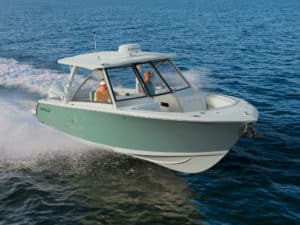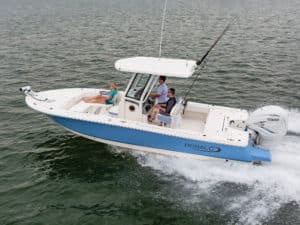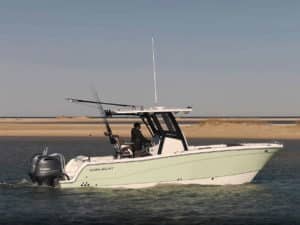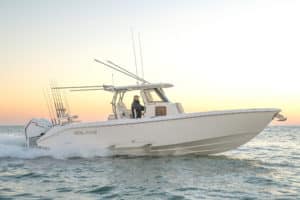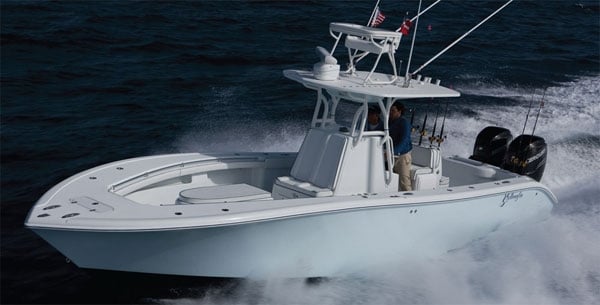
Lots of manufacturers claim their boats go fast across the seas, but you can count one one hand the ones that rightfully have that heritage. They all made the crossover from offshore racing to fishing at some point. Some made the switch wholesale, giving up racing altogether, while others still manage to race and fish at the same time. Yellowfin’s president, Wylie Nagler, comes from racing, but would rather fish than breathe. So while you won’t see him or his boats at APBA races anymore, you’ll consistently find his boats at the front of the pack at kingfish events, where the fast have a blast.
Performance
As luck would have it, seas were running only two to three feet from the southeast on the gorgeous south Florida spring day we tested the Yellowfin 32. I say “luck” because we ran out of one of the worst inlets on the East Coast – Hillsborough. Big seas out of the east or southeast cause surf to break all the way across the inlet mouth, just outside of a nasty dogleg in the channel. No such problem this time.
No matter how hard I tried, I found it impossible to launch this ventilated hull. It just wants to hug the sea’s surface like a magnet. Pulling the shifts into neutral left the Yellowfin’s bow to fall away from the wind until the boat drifted almost directly beam-to the seas, where it rolled very gently with comfortable transitions. In fact, throughout our performance runs, the Yellowfin 32 responded gently to all we asked of it, except it turns more sharply than you would ever want to. Be careful not to eject any passengers.
Surprisingly, Yellowfin designed this boat to carry strictly twin engines, unlike many of its other boats that readily handle triples and even quad applications. Of course, with the introduction of 350 hp outboards, even with twins, this 32-footer can benefit from up to 700 horsepower. With the standard 300 hp package on our transom, the 32 hopped onto plane in just under four seconds, cruised efficiently at a very respectable 40 mph, using 24 gph while turning only 4,300 rpm. At top speed, we hit 57.5 mph, burning 60 gph – obviously a speed at which you won’t want to spend a lot of time with today’s fuel prices. However, this boat had a very cool upper control station. With a clean T-top, the 32 tops out slightly above 61 mph.
I find it interesting that when working at idle speed around docks, some outboard boats maneuver sideways well and others don’t at all. The Yellowfin 32 handles this trick superbly. And once you learn how, it makes you look so good to those standing on the pier.
Trolling speed produces virtually no surface turbulence from the hull moving through the water. On centerline, you’ll find limited subsurface white water stretching back to about the second wave.
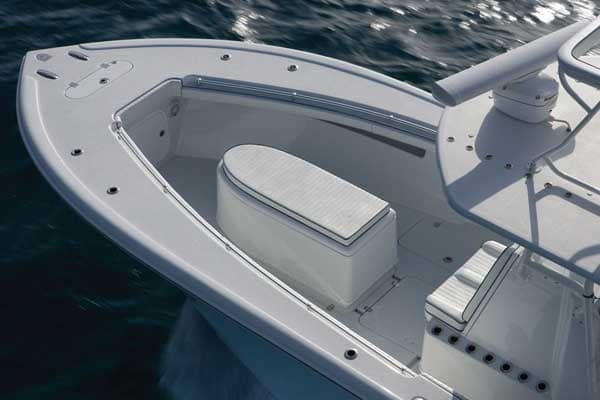
In summary, up-sea, down-sea, beam or quartering in any direction, the Yellowfin 32 proved to be dry, soft, solid, quiet and comfortable with no untenable idiosyncrasies.
Fishing Though I abhor fanaticism in any form, I must admit to appreciating what that character flaw can accomplish when unleashed in a fishing boat. The standard equipment list calls for four rod holders in each gunwale, but our test vessel sported dozens, stretching from stem to stern on both sides. You also get everything you’d expect in a top-flight fishing machine, such as huge port and starboard fish boxes, additional rod holders lining both sides of the console, removable tackle boxes in the leaning post, a 60-gallon livewell and an insulated coffin box on the foredeck that hides an even larger storage space belowdecks.
As to the question everyone inevitably asks about every boat, “Does it raise fish?” In the two hours we spent running and fishing out of Hillsborough Inlet in late spring, we raised, hooked and released five sailfish. Enough said.
Design and Construction
Most of the hardware aboard the Yellowfin comes from Gemlux – a high-quality metals manufacturer. It provides Yellowfin with a stainless-steel pop-up bow light, 2-inch stainless gas fills, and stainless thru-hulls and ball valves. Actually, you can rest assured every ingredient that goes into building a Yellowfin is the best that money can buy. For example, the company laminates its boats with Core-Cell composite for superb strength without additional weight.
A large lazarette under the cockpit makes accessing all the boat’s pumps and fuel filters a breeze. And every hatch on the boat has a glossy gelcoat finish top and bottom, sports a gasket for watertight integrity and opens with stainless-steel rams. Additionally, electrical connections consist of tinned copper wiring with waterproof Deutsch connectors.
Yellowfin has no dealers. Interested buyers have the pleasure of dealing directly with the source – where no question goes unanswered (correctly) and no fact about a Yellowfin is unknown. If you’d like to experience the passion of the Yellowfin builder, contact president Wylie Nagler.
Specifications
LOA……32 ft. 6 in.
BEAM……9 ft. 9 in.
HULL DRAFT……1 ft. 7 in.
DEADRISE……22 deg.
WEIGHT……8,200 lb. (w/ power)
FUEL……225 gal. (standard) 100 gal. (additional option)
MAX HP……Twin 350 hp OB
MSRP……$157,000 (w/ Twin 300 Mercury Verados and trailer)
Yellowfin Yachts / Sarasota, Florida / 941-753-7828 / www.yellowfinyachts.com

